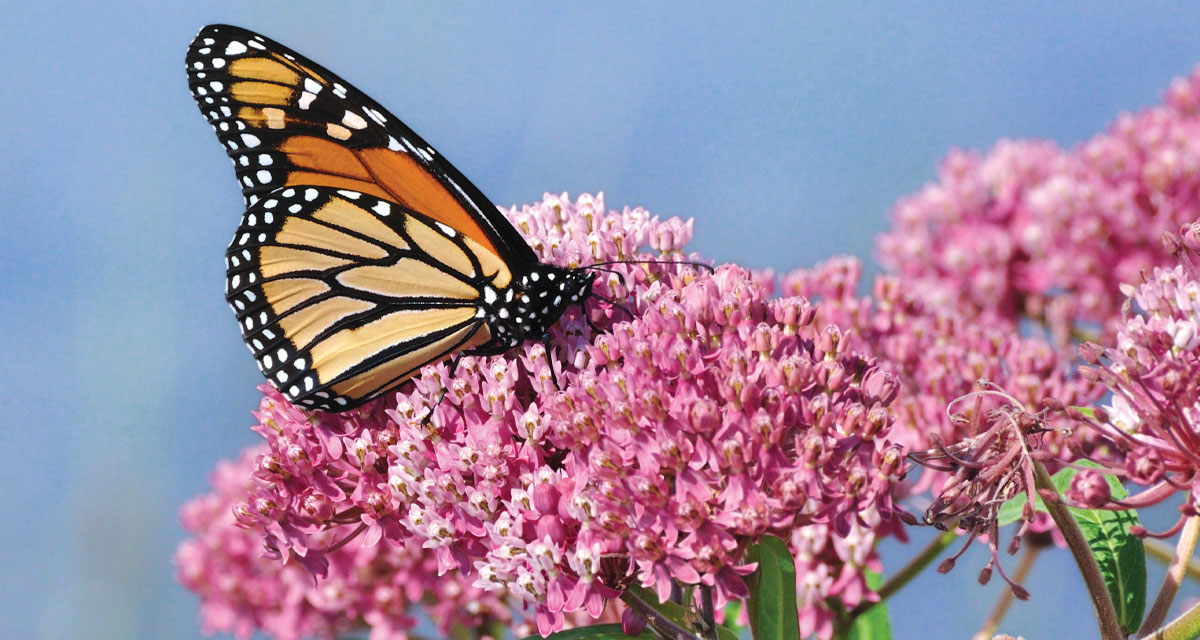The miraculous, fragile creature is a sight to behold. It weighs about as much as a paper clip. In the Mexican forests, the branches of fir trees once bowed, ever so slightly, from the numbers of hibernating Monarchs. Today, the species is on the verge of extinction. Populations are down by 90% in the last 20 years. In addition to the lack of its primary food source, milkweed, other factors include the depletion of forests and grasslands. While social and government agencies seek the goal of saving the Monarch, you, too, can become an advocate to join the effort. And, through expanding your gardens, you’ll be saving more than one essential winged flyer!
The Value of Milkweed Plants
In nurseries, how often do you see the native plant labeled “Common Milkweed?” A rare find indeed; however, it grows wild in fields, alongside roads, and can be discovered in packets at seed swaps. It once grew alongside agricultural fields until toxic pesticides impacted its ability to flourish, and it did not re-emerge. The Monarch relies on this plant that grows up to six feet tall to eat and lay eggs on its broad leaves. The clusters of white or purple flowers blooming from June through August contain nectar for all pollinators. And, ladybugs are just one beneficial insect that feasts upon the aphids. By late summer, pods form and burst to spread seeds and multiply, which makes it difficult to remove, once established.
Unfortunately, it has a negative reputation. This plant, along with daffodils and daylilies, hydrangea and azaleas, is toxic to dogs and cats. To humans, the milkweed sap can irritate the skin by producing a slight rash.
Create a Wildflower Garden
Unlike a patch of earth with bunches of flowers meticulously placed to create an appealing landscape, a sunny location full of wildflowers does not require cultivation. The untamed nature of pollinating plants growing freely in the wild allows a quick spread of self-seeding flowers. Fortunately, seed mixes are readily available for our zone, containing the variety of annual, biannual, and perennial flowers that appeal to pollinators. The easy solution for a plant like milkweed is to include it in your wildflower garden! And, welcome the Monarchs, too!
Avoid Using Pesticides
Warning labels, at times, do not divulge the entire truth. As you start shopping for a potentially safe herbicide or pesticide, it is important not to be rash, and to research the ingredients first. Despite weeds having a multiple herbicide resistance, which implies they require more than two or more chemicals to eliminate, plus, perhaps, repeated treatments, the flowers, on the other hand, do not have the same resistance to toxic ingredients, namely, 1,3-dichloropropene, glyphosate, and pelargonic acid.
Warning: Be wary of purchasing plants that contain Glyphosate herbicides. While it may reduce weeds upon planting, it can cause the premature death of surrounding plants, especially the milkweed.
Alternative: Try a DIY insecticide combining one cup of oil with one tablespoon of dishwashing liquid; then, pour four teaspoons into a spray bottle with two cups of warm water. Afterward, spray on the leaves to reduce the infestation of harmful insects.
Calling All Butterflies!
When the butterflies come, witness the brilliant colors of orange and yellow, and white dots on black arrive fluttering through the yard. No matter where you live, consider planting native milkweed and nectar plants. She’ll come attracted by the sweet aroma of the milkweed plant to lay eggs and establish a colony for the future! Join the cause! Advocate for school pollinator gardens and in local parks. It’s possible to increase the numbers of Monarchs. It all begins by planting milkweed!



















